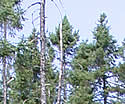Picea mariana (Black Spruce)
| Also known as: | |
|---|---|
| Genus: | Picea |
| Family: | Pinaceae (Pine) |
| Life cycle: | perennial woody |
| Origin: | native |
| Habitat: | sun; northern swamps and bogs |
| Bloom season: | June |
| Plant height: | 30 to 50 feet |
| Wetland Indicator Status: | GP: FACW MW: FACW NCNE: FACW |
| MN county distribution (click map to enlarge): |  |
| National distribution (click map to enlarge): |  |
Pick an image for a larger view. See the glossary for icon descriptions.
Detailed Information
Flower:
Male and female flowers are cone like structures called strobili, both borne on the same tree at or near the tips of one year old branches. Male strobili are oblong cylindrical between 1/3 to just over ½ inch long, on a short stalk, initially red turning yellowish-brown. Female strobili are erect when young, egg shaped, about ½ inch long, and purple.
Leaves and bark: 

![[photo of blunt needles, and branch bud]](/udata/r9ndp23q/pd3/picea-mariana-6837-2-t.jpg) Leaves are needle-like, dark green to bluish, single in a close spiral up the branch, ¼ to ½ inch long, squarish in cross section, the tip blunt and not sharp to the touch. The needles can persist up to 10 years.
Leaves are needle-like, dark green to bluish, single in a close spiral up the branch, ¼ to ½ inch long, squarish in cross section, the tip blunt and not sharp to the touch. The needles can persist up to 10 years.
![[photo of twig with scattered hairs]](/udata/r9ndp23q/pd3/picea-mariana-6837-5-t.jpg) Twigs are reddish brown with scattered short hairs, turning gray after several seasons with the fallen needles leaving raised roughish leaf scars.
Twigs are reddish brown with scattered short hairs, turning gray after several seasons with the fallen needles leaving raised roughish leaf scars.
![[photo of trunk]](/udata/r9ndp23q/pd3/picea-mariana-78349-4-t.jpg) The bark is thin and gray or brownish with flaky scales. Trunks can reach up to 19 inches in diameter at breast height (dbh).
The bark is thin and gray or brownish with flaky scales. Trunks can reach up to 19 inches in diameter at breast height (dbh).
Fruit: 
![[photo of cones]](/udata/r9ndp23q/pd3/picea-mariana-89-5-t.jpg) Fruit is a brown, elliptic to egg-shaped cone, ½ to 1¼ inch long, hanging from the tips of twigs. Scales are rounded at the tip, with tiny, irregular teeth along the tip edge.
Fruit is a brown, elliptic to egg-shaped cone, ½ to 1¼ inch long, hanging from the tips of twigs. Scales are rounded at the tip, with tiny, irregular teeth along the tip edge.
Notes:
Black Spruce shares its range with our native White Spruce (Picea glauca), which is a much larger, upland forest species with longer needles and larger cones. Black Spruce can survive in nutrient poor bogs that other species can't tolerate, forming larger pure stands of spindly, dwarfed trees. In more productive swamps it can be found mixed with Tamarack (Larix larcina), Northern White Cedar (Thuja occidentalis) and to a lesser extent Balsam Fir (Abies balsamea), but is easily distinguished from all these species by its short, squarish needles and small egg-shaped cones. While an important resource for the manufacturing of paper, for all intents and purposes, Black Spruce is rarely, if ever, used in landscape plantings. A highly destructive, albeit interesting, pest of Black Spruce is Dwarf Mistletoe (Arceuthobium pusillum), a parasitic flowering plant capable of causing extensive mortality in pure Black Spruce stands.
Native Plant Nurseries, Restoration and Landscaping Services ↓
More photos
Photos courtesy Peter M. Dziuk taken in Anoka, Aitkin and Lake counties.
Comments
Have you seen this plant in Minnesota, or have any other comments about it?
on: 2019-07-14 21:29:12
These are quite common in NE Minnesota. I see them in every bog and some upland areas, usually along with Tamarack.
on: 2020-05-08 22:38:26
Have seen a few young ones growing in the perching marsh, maybe from cones from tree toppings used as decorations thrown in the ravinces?







 a young Black Spruce tree
a young Black Spruce tree Black Spruce trees
Black Spruce trees tree line of a Black Spruce bog
tree line of a Black Spruce bog immature cones
immature cones